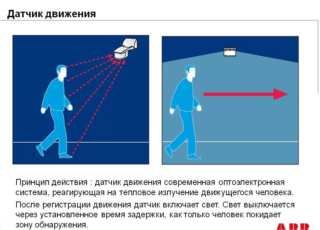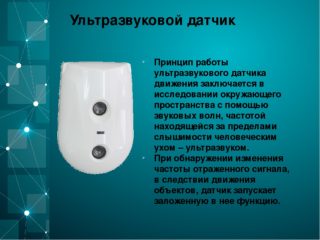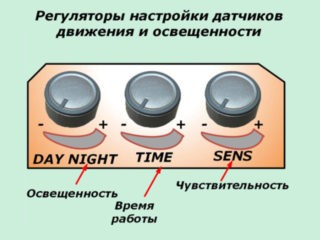Various automation devices are used to provide comfort and convenience. This is especially true for the lighting system. With the help of sensors of presence, illumination, movement, the light can be automatically turned on and off. Such systems also allow you to save energy. You can install a device with a motion sensor yourself, you just need to know the basic principles of operation and the installation method.
Principle of operation
Using infrared radiation, the coverage area is scanned. If the sensor detects the appearance of an object with the temperature inherent in a living creature, several pulses are sent. They act on the electrical circuit and close it, as a result of which the lamp lights up. In the absence of impulses, the circuit is broken and the electricity is cut off.
The advantages of sensors include:
- Energy saving. The luminaire works only when there are people in its line of sight. You can increase your savings by using LED lamps.
- Versatility. It can be connected not only to lighting devices, but also to a TV, coffee machine and other appliances.
- Providing additional security for the home.
- Convenience of management.
Disadvantages:
- Price.
- Complexity of installation.
Installation and adjustment of the sensor depends on its type.
Sensor types
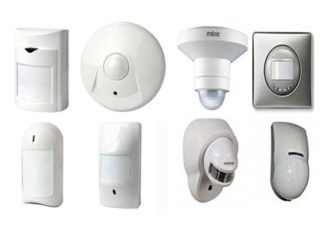
At the place of installation, external and internal devices are distinguished. Outdoor are used on the street - for example, for adjoining space or outbuildings. The range can reach 500 m. There are specialized devices that cover a large area.
Indoor sensors are used in homes and apartments. They are less resistant to UV radiation and temperature fluctuations. They are often installed in garages, closets, corridors, toilets. They also act as a security system.
- Ultrasonic. Ultrasonic waves are reflected from the surface of objects and walls. If there is movement in the visibility zone, the waves change frequency, which is fixed by the sensor. These devices are inexpensive and weatherproof. Among the shortcomings, one can single out discomfort in animals that are sensitive to ultrasound, and a response only to rapid movement.
- Infrared. IR sensors measure the temperature of the room and react if a high-temperature object enters the field of view. The advantages include the ability to adjust the range and angle of action, the ability to use outside the home, as well as complete safety for humans and animals. Cons - a high risk of false alarms (for heaters, kettles and other devices with high temperatures), instability to weather conditions.
- Microwave. It works on the principle of a radar - it sends a signal and receives a reflection. If the return signal is violated, the circuit is turned on and the light comes on. It is a more modern device than an ultrasonic sensor. Such devices can scan the area behind glass or a thin wall, work at any temperature, and also capture the slightest movement.Disadvantages - the highest cost of all types, increased sensitivity and the risk of negative effects on human health.
- Combined. The sensor uses a combination of several sensors, which reduces the risk of false alarms and scans the range more thoroughly. The disadvantage of such a device is its high cost.
Popular manufacturers include Camelion, Theben, Ultralight. The price starts from 400 rubles per item. Externally, it may look different, so it is easy to choose a device for any interior.
Specifications
- Viewing angle. It can be from 90 to 360 degrees for the horizontal plane. Indoors, sensors with a narrow viewing angle are usually installed. This parameter is selected depending on the installation location and viewing area. There is also a vertical viewing angle. In cheap models it is 15-20 degrees, in expensive devices it can reach 180 degrees.
- Range of action. Also depends on the location of the sensor. The optimum value for a house is 2-4 meters.
- Power of the connected light source. To save money, it is recommended to install energy-saving fluorescent or LED lamps.
- Method and place of attachment. Case models can be mounted on a bracket. There are ceiling and wall models. Recessed models are installed in a pre-drilled hole in the wall.
- Additional functions. These include the presence of a light sensor, animal protection, light off delay. Additional options increase the total cost of the detector.
For wireless models, the type of power supply and operating frequency are also taken into account. All characteristics are indicated in the passport of the device and on its packaging.
Choosing a location
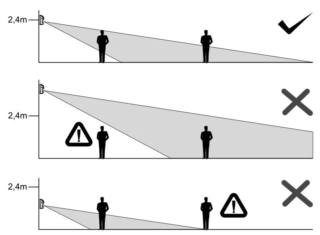
The correct operation of the sensor will only be ensured if the installation location is correct. There should be no lighting devices nearby that can interfere with work, as well as heating systems and air conditioners.
It is important to remember that as the installation height increases, the viewing area will expand. This will decrease the sensitivity. Large objects also affect the operation - they can obscure part of the field of view, which is why the sensor may not detect movement.
If the sensor is installed in a large room, it is best to mount it to the ceiling. You need to choose a model with a 360-degree viewing angle. The blind spot should be as small as possible - this should be taken into account when drawing up the installation diagram.
Installation diagrams
The simplest scheme is to connect a phase to a break in the wire that goes to the luminaire. This method is used in rooms without windows. The zero wire is also connected to the sensor, and from it the phase goes to the lamp. Zero and ground are supplied from the switchboard.
If street lighting is created, it is recommended to additionally install a photo relay or switch. With their help, you can not turn on the flashlight during daylight hours, it will work only in the evening and at night. They are also installed in a phase gap in front of the motion sensor.
When placing the sensor on the light, it is important to remember that in the absence of movement, the lighting will go out, so the lamp will not burn for a long time. To keep the light on for the required time, you can install a switch in parallel. The lamp will stay on while the switches are in the “on” position.
Setting DD
The tilt angle is set first. This is done by rotating the sensor itself, which is attached to the wall with a bracket. It is impossible to give an exact adjustment algorithm - it all depends on the installation height, the individual characteristics of the room and the chosen model. There are recommendations for choosing the optimal height - 2.4 meters.Then even sensors with a coverage of 15-20 degrees can scan a fairly large area.
The sensitivity is marked as SEN on the body. The position of the lever changes from minimum to maximum. This is the most difficult setting, as even the smallest amount of lever displacement can result in a response to small pets. The setting procedure is as follows: first, the minimum is set and it is checked what it reacts to. Then the sensitivity is gradually increased to optimal values.
The delay time depends on the selected model. On average, it ranges from 3 seconds to 15 minutes. Set by turning the Time lever. The time that the user wants is set.
Light level refers to devices with light sensor. These are the most popular models for home use. The LUX lever is responsible for setting the illumination. It must first be put in the maximum position in the daytime. As the light in the room diminishes, the lever turns to the min position until the luminaire comes on.
Noise control is also used on some models. It is marked as MIC on the transducer body. You should set the minimum value so that the light is not turned on from a child's cry, a barking dog or noise from the street.

